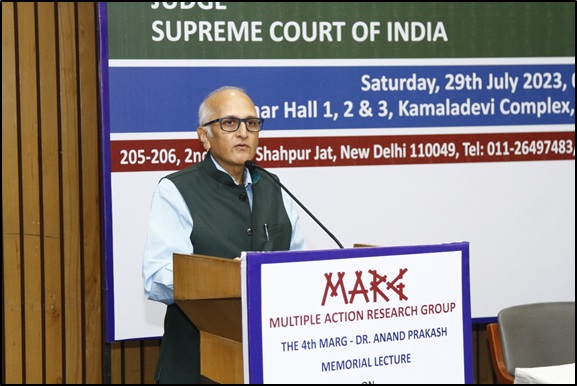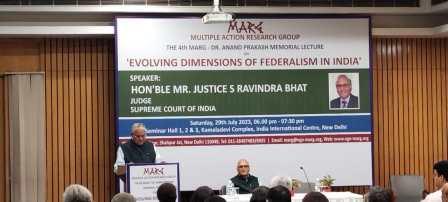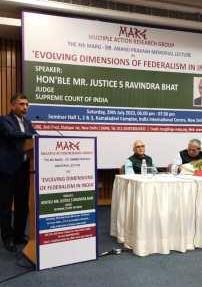4th MARG – Dr. Anand Prakash Annual Memorial Lecture, on the topic “Evolving Dimensions of Federalism in India
On the 29th July, 2023, from 6:00 p.m. to 7:30 p.m., Hon’ble Justice S Ravindra Bhat, Judge of Supreme Court of India delivered his speech at the Indian International Center for the 4th MARG – Dr. Anand Prakash Annual Memorial Lecture, on the topic “Evolving Dimensions of Federalism in India”.
The lecture started off with the welcome speech by Mrs. Seema Misra, the executive member of MARG, wherein the growth, aim and achievements of the organization, followed by the felicitation of Mr. K.K. Rai, chairperson of MARG and Senior advocate of Supreme Court and the speaker of the day, Mr. Justice S. Ravindra Bhat.
Later on, Mrs. Abha Singhal Joshi, the ex-executive director of MARG, took the privilege to introduce, in fact took a moment for reminiscing about late Dr. Anand Prakash, who always stood as a great legal luminary. He was a person who was greatly respected by all in the profession but he still never took to his advantage and always stayed to be humble and courteous to all. She also mentioned about hos he was also involved in the Quit India Movement and the independence of India. This clearly showed how he always stood by his people and made an equal and righteous fight for all.
Once the seminar was inaugurated, Hon’ble Justice Ravindra Bhat was invited on for his speech while introducing the topic, by Mr. K.K. Rai, who followingly talked on the achievements of the speaker and various cases related to the topic. He then gradually went onto introducing the topic and calling the speaker onto the podium.
Justice Ravindra Bhat started his speech off with explain that just like any other term, federalism has also seen its evolution over time, which dates back to times of kingdoms, empires which started as a loose knit empire to a heavily centralized empire and territory like the Ganasanghs that later became the empires in their own right, Mauryan empire, Mughal revenue system or even Vijayanagar empire, all of these were organized in federal units for administrative convenience. For sure the truth behind the purpose of introducing such systems will always be speculative in nature but there are reasonable proofs like textual records under the patronage of rulers themselves and the accounts of travellers and we have foreign travellers like Fayan, Hunsang and so on which form the sources of such history confirm that, the great thought went into these methods of organization and administration employed by rulers.
Chanakya’s Arthashastra is believed to have shaped the extensive bureaucracy of the empire with a civil service. The Mahamatya system established in this era is often credited for the inspiration in bureaucratic organization which evolved down the time into the Jagirdari system, the Mansabdari system during the Mughal era, the British Indian civil service and finally, the All-India services consisting of IAS, IPS and IFS.
Jump to the 1500s where the Mughal emperor Akbar improved upon Shershah’s land revenue system and divided his empire into 12 provinces or Subas which were designated to be efficient tax revenue collection units. Akbar’s four central departments, finance, war, judiciary and supply were replicated at the provincial level as well. By the time Aurangzeb took over who had himself started as a Subedar of a province, there were 21 provinces consolidated under Mughal rule.
In the British India, the landscape of federalism changes as the Charter Act, 1833 was introduced causing centralisation of the administration and making East India Company’s domain the subject of the Crown’s trust. But then after the 1857 War of Independence, it was realised that decentralisation f power had to be the strategy to administer such a vast territory and the Indian Council Act of 1861 sought to reverse the trend of the 1833 Act.
Once India became independent, it was still held in the circle of fire wherein a lot of traumas was seen resulting in the creation of Pakistan. Haunted by this, the Indian National Movement faced further challenges of integration of princely states and British India. This witnessed for the first-hand need for a strong central government that could lead development and influence reform while maintaining stability among the federal units. The new federal system had to be protected from threats to its integrity. Dr. Ambedkar during the Constituent Assembly debates said that in normal times constitution is framed to work as a federal system but in times of war it is so designed as to make it work as though it was a unitary unit. Therefore, we can see high level of flexibility in our present constitution enabling its responsiveness in the face of adverse circumstances. The centre is often the source of policy but is highly dependent on the states for the actual implementation of the initiatives and programs. This is why the phrase cooperative federalism has been such a catchy characterization. It recognizes that governance in our country relies heavily on intergovernmental collaboration where the Union can overstep in areas of national interest and unity.
In the SR Bommai judgment, it was said that federalism though not mentioned in the constitution but it does form the basic structure of constitution. But a lot of the times people have attacked the structure saying that it was too centrally biased to be called a federation as smaller state size experiences limited influence in the Union Parliament. This led to each scholar tagging it differently like quasi-federation, administrative federation, organic federation but all have agreed on one aspect that the federal structure is unique one of a kind molded with special attention and care to fit the needs of the post-colonial democracy like India.
The centralizing tendency can be seen in various provisions like article 200 by which certain bills passed by the state can be reserved by the governors for consideration of the president and article 201 which gives the president a veto. Both of these are without time limit. This the misuse of this power was seen most drastically from 1977 to 1985 where some 1130 bills were said to have been reserved for the president’s consideration with vetoes being rendered almost 12 years later. There have been calls for the deletion of such provisions by numerous state governments. There is another provision called article 254 which stipulates that when a state law inconsistent with an existing central law which is possible in some areas especially the list called the third list or the concurrent list. To the extent that there is inconsistency the law of the state becomes void or it is unenforceable. There is one provision which empowers the union to intervene in state affairs under three well-known circumstances which is external aggression, internal disturbance and when the state government is carried on in accordance with the constitution.
These provisions however cannot be relied on to arrive at this oversimplification that India is only quasi-federal or that the powers of states are without a bite. The flexible model of federalism was carefully calibrated to ensure that the union could respond in emergency situations that numerous areas of law required uniformity or when non-negotiable minimum standards the union had to maintain could be addressed accordingly. There are numerous examples that illustrate lucidly why the centre holds the legislative field in certain key subjects. The Rright to Information movement for instance culminated in some state enactments, many states did not enact any law. Another example being right to equal opportunity for public employment, which is available to all citizens but the state has the power to classify to make certain laws and impose certain qualifications and yet there is one area where only Parliament can intervene which is in the case of requiring residence requirements in relation to the right to public employment as each state may come out with its own residence requirement.
But at the same time something to note is that, all these decisions cannot be all let in the hands of the state since they would all have differences in called out for a right like right to education became a fundamental right which is decided by the Parliament which therefore stands to be uniform throughout the country but then if it was let out to the sate to decide on this they would have a differing perspective and therefore the expected uniformity of laws throughout the country won’t be achieved. Then we have programs like the MNREGA. The centre creates the right, the states implement it.
This shows that the constitutional order permits differential treatment of regions based on their unique necessities and based upon their progress and developments and also having regards to multiple pluri-ethnic or pluri-national countries like in the case of Jammu and Kashmir.
When we talk about panchayats, it has showed the world clearly from the past that these bodies are empowered to make rules laws within the framework of state laws entirely. So, we have certain taxes which can be enforced by panchayats. Of course, the state has to impose the tax but the rate and other principle can be worked out by the panchayats.
From the beginning our constitution distinctly defined the roles and responsibilities of both central and state governments concerning expenditure and the instrumentalities required for its implementation. One provision article 282 specifically empowers both union, the union to provide grants for any public purpose irrespective of whether that has the power or the states have the power.
One of the most sweeping changes that happened in India’s fiscal federal structure was the introduction of the GST through the amendment. With the introduction of the GST regime, all the various indirect taxes were merged and replaced by one tax. Now, this GST in short tries to embody one nation – one tax, one nation – one market so that all economic barriers are overcome and it seems to be unitary.
The Supreme Court mentioned in one of its recent judgments which is Mohit Minerals that the observations made in Bommai highlighting the federal character through the concept of exclusive and equal distribution, the amendment actually granted both parliament and state legislatures simultaneous powers. Now, it would seem that if both parties have the same power, then you can grab as much as you want which can result in chaos. But also, the constitution made a very beautiful arrangement called a uniquely created one where neither the union nor the state will have the final say. It is left to the GST council and the composition of the GST council is also very unique. It is comprised of all the states and the representative of the centre where two-thirds participation is through the states and one-third with the centre and when it comes to a decision, there has to be a three-fourths majority which means that there has to be unanimity, almost near unanimity in the kind of taxes and what items are to be taxed and who is to do it.
Therefore, we can see that, undoubtedly, there are provisions which give a larger role to the centre to step in but equally there are provisions which empower the states to protect their geographic and contextual interests. So, the often-political parties have ruled in the state domain without forming the government at the centre. Occasion has risen in the recent past that when such parties have come to power at the centre, with their experience informs the policymaking approach. In short, the ability to bargain is directly impacted by the political compact and the shape of the party. Therefore, in theory, what may seem to be very unitary in its formulation is actually dependent on the states, the parties that govern them and the cooperation among them. The challenges to our federal structure, if any, will be along these fault lines.
Vote of Thanks:
The seminar was brough to an end by Mr. Saurabh Anand Prakash, advocate of Delhi High Court, wherein he talked about many other previous lectures that Justice Ravindra Bhat has given, followed by appreciating his presence for the day and the wonderful speech that he delivered.










